top of page

Stubbs Collections

"Self Portrait" (1949)
By Otho R. Stubbs (1907-1996)
Oil on board
18"x 14"
This self-portrait by Stubbs, created in 1949, depicts the artist in his early 40s, just a few years after his service in World War II with the Fifth Armored Division of the U.S. Army.
Ajar Vision
Oil on board
18"x 14"
This self-portrait by Stubbs, created in 1949, depicts the artist in his early 40s, just a few years after his service in World War II with the Fifth Armored Division of the U.S. Army.
Ajar Vision

"The Stampede" (1991)
By Otho R. Stubbs (1907-1996)
Oil on canvas
25" x 37"
In this painting, as in many others, the artist reflects on his experiences as a young cowboy, having worked on ranches throughout the Texas Panhandle and New Mexico. The swirling dust from the stampede, the flashes of lightning in the dark sky, and the herds rushing into the arroyo create a visceral sense of movement for the viewer. The artist provides a detailed account of this stampede scene in his memoir. For those interested in purchasing the first edition of the book, please visit our online store via the menu bar.
Ajar Vision
Oil on canvas
25" x 37"
In this painting, as in many others, the artist reflects on his experiences as a young cowboy, having worked on ranches throughout the Texas Panhandle and New Mexico. The swirling dust from the stampede, the flashes of lightning in the dark sky, and the herds rushing into the arroyo create a visceral sense of movement for the viewer. The artist provides a detailed account of this stampede scene in his memoir. For those interested in purchasing the first edition of the book, please visit our online store via the menu bar.
Ajar Vision
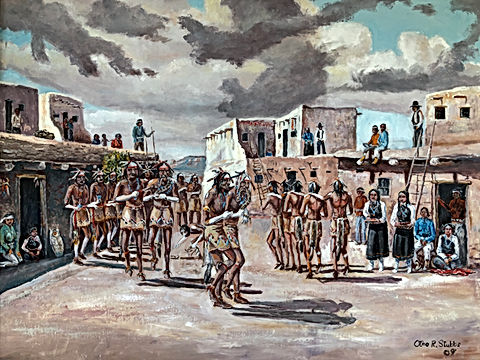
"Hopi Snake Dance" (1991)
By Otho R. Stubbs (1907-1996)
Oil on canvas
22" x 28"
The artist journeyed through the Painted Desert in Arizona and camped atop Polaka Mesa, near the Hopi Reservation. There, he experienced the sacred Hopi Snake Dance ceremony. An excerpt from the book "Otho Stubbs, A Lasting Legacy" on our blog will guide readers through this remarkable ritual. To purchase the first edition of the book, please visit our online store in the menu bar.
Ajar Vision
Oil on canvas
22" x 28"
The artist journeyed through the Painted Desert in Arizona and camped atop Polaka Mesa, near the Hopi Reservation. There, he experienced the sacred Hopi Snake Dance ceremony. An excerpt from the book "Otho Stubbs, A Lasting Legacy" on our blog will guide readers through this remarkable ritual. To purchase the first edition of the book, please visit our online store in the menu bar.
Ajar Vision
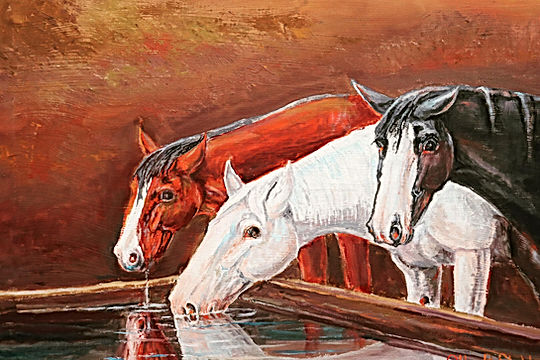
"At the water trough" (1995)
By Otho Stubbs (1907-1996)
Oil on canvas
16" x 20"
From a young age, the artist was captivated by drawing the animals on the ranch. Growing up alongside cowboys, he closely observed livestock as they grazed and approached water to drink. He was particularly fascinated by the markings and colors on horses and cows. His meticulous study of their anatomy included capturing the interplay of light and shadow on their muscles, often while watching their reflections in the water.
Ajar Vision
Oil on canvas
16" x 20"
From a young age, the artist was captivated by drawing the animals on the ranch. Growing up alongside cowboys, he closely observed livestock as they grazed and approached water to drink. He was particularly fascinated by the markings and colors on horses and cows. His meticulous study of their anatomy included capturing the interplay of light and shadow on their muscles, often while watching their reflections in the water.
Ajar Vision

"The First Snow" (1991)
By Otho R. Stubbs (1907-1996)
Oil on canvas
20" x 24"
The house depicted in this painting, along with many other works by the artist, is a tribute to a residence in McLean, Texas, built in the 1890s with a six-gabled hipped roof. The gables are shingled in a scalloped pattern. The hay rake in the front yard is inspired by an illustration from a 1898 Sears catalog.
—Excerpt from "A Lasting Legacy," p. 69, by Otho R. Stubbs.
Ajar Vision
Oil on canvas
20" x 24"
The house depicted in this painting, along with many other works by the artist, is a tribute to a residence in McLean, Texas, built in the 1890s with a six-gabled hipped roof. The gables are shingled in a scalloped pattern. The hay rake in the front yard is inspired by an illustration from a 1898 Sears catalog.
—Excerpt from "A Lasting Legacy," p. 69, by Otho R. Stubbs.
Ajar Vision
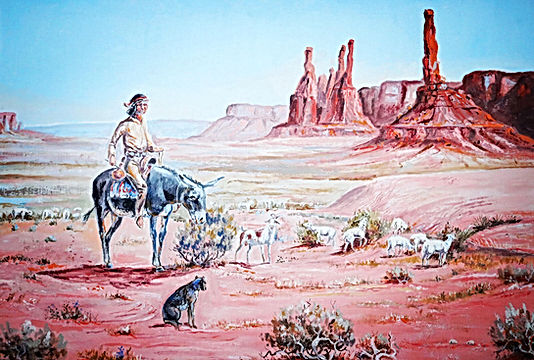
"Little Herder" (1995)
By Otho R. Stubbs (1907-1996)
Oil on canvas
20" x 23"
Grazing is sparse in this desert landscape, primarily consisting of sand, shade, and sagebrush. We find ourselves in Monument Valley, where a Navajo boy is herding sheep and goats. He has paused to rest in a spot that offers some greenery for his donkey and the sheep. In the background, mesas rise 500 to 1,000 feet above the surrounding terrain. A goat watches the boy closely, while the vivid reds, browns, and pinks of the sand are characteristic of this region.
Ajar Vision
Oil on canvas
20" x 23"
Grazing is sparse in this desert landscape, primarily consisting of sand, shade, and sagebrush. We find ourselves in Monument Valley, where a Navajo boy is herding sheep and goats. He has paused to rest in a spot that offers some greenery for his donkey and the sheep. In the background, mesas rise 500 to 1,000 feet above the surrounding terrain. A goat watches the boy closely, while the vivid reds, browns, and pinks of the sand are characteristic of this region.
Ajar Vision

"A Raining Camp" (1990)
By Otho R. Stubbs (1907-1996)
Oil on canvas
20" x 24"
"Under a rock shelter to protect from the falling rain, two cowboys are making night camp. A coffee pot sits over the fire beckoning the cowboy to enter and get warm. The pack saddles are drying against the back wall. Horses are being hobbled in the valley for the night. Water dripping from the sides of the cliff, let the observer know that it is still raining..."
Extract form the artist's memoir: Otho Stubbs, A Lasting Legacy.
Ajar Vision
Oil on canvas
20" x 24"
"Under a rock shelter to protect from the falling rain, two cowboys are making night camp. A coffee pot sits over the fire beckoning the cowboy to enter and get warm. The pack saddles are drying against the back wall. Horses are being hobbled in the valley for the night. Water dripping from the sides of the cliff, let the observer know that it is still raining..."
Extract form the artist's memoir: Otho Stubbs, A Lasting Legacy.
Ajar Vision

"St. Lo, France" (1983)
By Otho R. Stubbs (1907-1996)
Water on paper
18" x 24"
From the series of "My War Experience" chap. IV, (A Lasting Legacy), work#1
The four World War II paintings stand apart from the artist's usual medium of oil. This series was created using watercolor, chosen for its speed and simplicity. Based on sketches made directly on the battlefield, these works vividly capture the artist's intense memories of the events he witnessed, leaving an indelible mark on his mind.
<<While at St. Lo, France, I had just exited my half-track to stand guard, when a German Jerrie plane shot at both sides of my vehicle. I made a run for what I thought was a hole. Making a long dive, I landed on knoll and into a pile of wire, The night was pitch black. The country had been burned, making the spot look like a hole. My water color shows our tank and half-track and the devastation here. The town was destroyed by artillery fire. Debris had been pushed aside by dozers and the area cleared of mines so we could pass. Shown is the German fighter plane ME 109 bombing a cathedral. I had to drive up onto the sidewalk to get around burning German tanks. Leaving St. Lo, our convoy split-up. >>
Ajar Vision
Water on paper
18" x 24"
From the series of "My War Experience" chap. IV, (A Lasting Legacy), work#1
The four World War II paintings stand apart from the artist's usual medium of oil. This series was created using watercolor, chosen for its speed and simplicity. Based on sketches made directly on the battlefield, these works vividly capture the artist's intense memories of the events he witnessed, leaving an indelible mark on his mind.
<<While at St. Lo, France, I had just exited my half-track to stand guard, when a German Jerrie plane shot at both sides of my vehicle. I made a run for what I thought was a hole. Making a long dive, I landed on knoll and into a pile of wire, The night was pitch black. The country had been burned, making the spot look like a hole. My water color shows our tank and half-track and the devastation here. The town was destroyed by artillery fire. Debris had been pushed aside by dozers and the area cleared of mines so we could pass. Shown is the German fighter plane ME 109 bombing a cathedral. I had to drive up onto the sidewalk to get around burning German tanks. Leaving St. Lo, our convoy split-up. >>
Ajar Vision
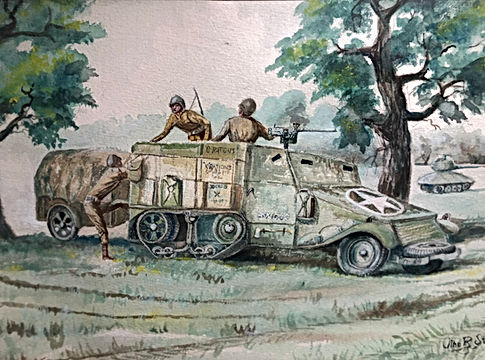
The Falaise Pocket, France (1983)
By Otho R. Stubbs (1907-1996)
Water on paper
18" x 24"
From the series of "My War Experience" chap. IV, (A Lasting Legacy), work #2.
<< About daylight we pulled into an apple orchard at Falaise Pocket and found that we had arrived ahead of the fighting force. This is the origin of my second painting in the series, entitled "The Falaise Pocket, France".
England didn't have the power to hold their lines, so the German Fifth Army pushed them back. I am the fifty caliber machine gun operator shown in the back of our half-track named Anxious. I remained with Anxious all the way through the war, both of us surviving to the end.
The truck seated eight men in the back. Notice on the front bumper is written 5th division, 46th Armored Infantry. The small container on the side contained our C and K rations. Camouflage nets, gasoline, and water were kept on the bumper. The trailer behind our truck carried ammunitions and spare parts for tanks >>.
Ajar Vision
Water on paper
18" x 24"
From the series of "My War Experience" chap. IV, (A Lasting Legacy), work #2.
<< About daylight we pulled into an apple orchard at Falaise Pocket and found that we had arrived ahead of the fighting force. This is the origin of my second painting in the series, entitled "The Falaise Pocket, France".
England didn't have the power to hold their lines, so the German Fifth Army pushed them back. I am the fifty caliber machine gun operator shown in the back of our half-track named Anxious. I remained with Anxious all the way through the war, both of us surviving to the end.
The truck seated eight men in the back. Notice on the front bumper is written 5th division, 46th Armored Infantry. The small container on the side contained our C and K rations. Camouflage nets, gasoline, and water were kept on the bumper. The trailer behind our truck carried ammunitions and spare parts for tanks >>.
Ajar Vision

"Hurtgen Forest, Germany" (1983)
By Otho R. Stubbs (1907-1996)
Water on paper
18" x 24"
From the series of "My War Experience" chap. IV, (A Lasting Legacy), work#3
<< The worst that I saw was at the Hurtgen Forest. We entered the forest at night. The entire woods was mined. Before daylight, the vehicle I rode in narrowly missed a personnel mine and pushed over a bouncing betty mine (AKA German S-mine). Dead were everywhere. Artillery fire never ceased. My painting shows the devastation of this event. An indelible impression has been made in my memory. Trees were damaged by artilleries barrages. The American half-track and tank shown in the picture were destroyed by German tank guns. Troops were shot by the bunches. >>
Ajar Vision
Water on paper
18" x 24"
From the series of "My War Experience" chap. IV, (A Lasting Legacy), work#3
<< The worst that I saw was at the Hurtgen Forest. We entered the forest at night. The entire woods was mined. Before daylight, the vehicle I rode in narrowly missed a personnel mine and pushed over a bouncing betty mine (AKA German S-mine). Dead were everywhere. Artillery fire never ceased. My painting shows the devastation of this event. An indelible impression has been made in my memory. Trees were damaged by artilleries barrages. The American half-track and tank shown in the picture were destroyed by German tank guns. Troops were shot by the bunches. >>
Ajar Vision
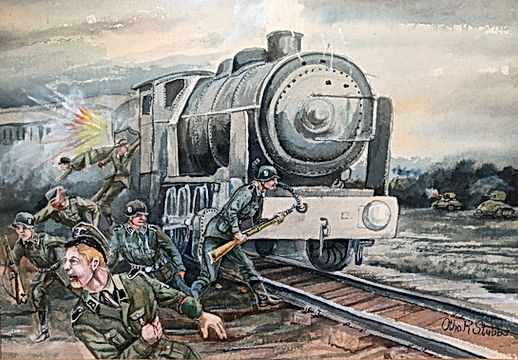
"German Troop Train" (1983)
By Otho R. Stubbs (1907-1996)
Water on paper
18" x 24"
From the series of "My War Experience" chap. IV, (A Lasting Legacy), work#4
<< The fourth painting in this series illustrates what happened when one of our tanks fired on a German Troop Train. Heavy steel flew and SS troopers exited in all directions. You can tell they were SS troopers by the crossbone and skull insignia on their collar. They carried eight millimeter rifles. >>
Ajar Vision
Water on paper
18" x 24"
From the series of "My War Experience" chap. IV, (A Lasting Legacy), work#4
<< The fourth painting in this series illustrates what happened when one of our tanks fired on a German Troop Train. Heavy steel flew and SS troopers exited in all directions. You can tell they were SS troopers by the crossbone and skull insignia on their collar. They carried eight millimeter rifles. >>
Ajar Vision
bottom of page

